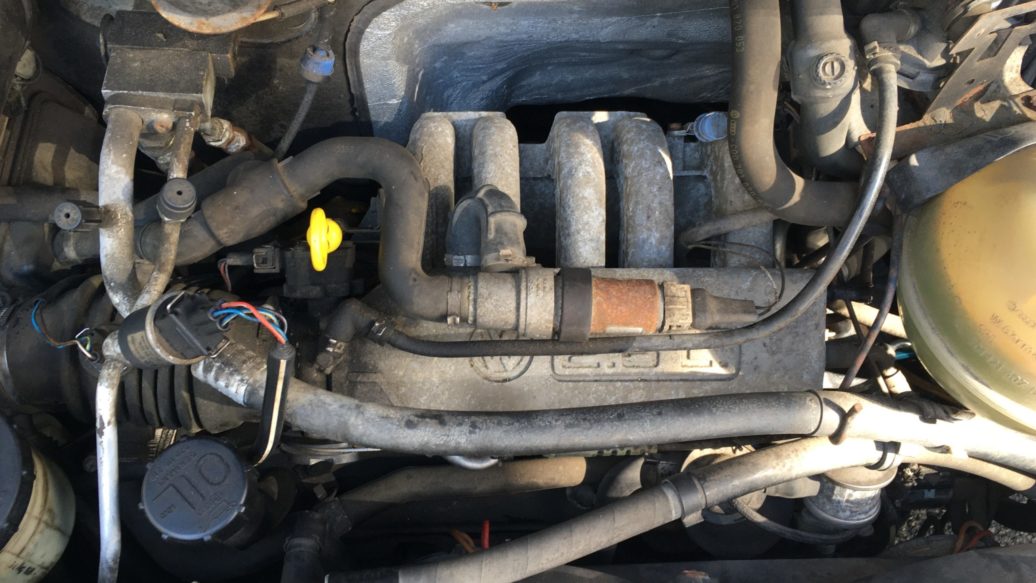Last week I discussed two very different cars—my E39 530i stick sport (ostensibly my daily driver) and my 1996 Winnebago Rialta, our little Volkswagen Eurovan with a Winnebago camper body on it—whose disparate roles in my life seemed temporarily bound together by dependability issues. The E39 died last month, the root cause very likely being cavitation/vapor lock triggered by high temperatures and a low fuel level. That’s both great and awful at the same time, because on the one hand it means that you don’t really have to take any repair action other than keep more fuel the tank, but on the other hand, if the car strands you because it needs a fuel pump, you’re going to feel like a major doofus.
Similarly, the Rialta died while at the car wash, then magically resurrected itself. My wife and I were about to take it on a short vacation to the Cape, so I really wanted the symptom to repeat so I could nail it.
I got my wish.
I’d gone out to the driveway one morning to complete a round of fluid changes on the Rialta. It had rained the night before, so things were damp. I twisted the key, but the Rialta wouldn’t start. “Yes!” I thought. “Praise to the Automotive Powers That Be!” Dead in your driveway is so much better than dead by the side of the road… with your wife in it.
When the Rialta originally died at the car wash, I certainly suspected the culprit to be ignition. After all, the image of a vintage (*cough* British *cough*) car that won’t start in the rain is almost always due to water getting under the distributor cap or seeping through cuts in plug wires and causing spark to arc to ground somewhere other than at the spark plugs. Now I had the chance to find out.
No matter the make or model, Dead-Car Troubleshooting 101 is to isolate the problem to spark or fuel. As I would do with any fuel-injected BMW, I pulled the fuel pump relay out and put a jumper between Pins 30 and 87. I heard the fuel pump run, and felt fuel coursing through the rubber fuel lines that fed the pressure regular. I could’ve put a pressure gauge on it, but I was pretty confident that it had fuel. To make the test more certain, I pulled the air cleaner off and gave the intake a blast of starting fluid while my son Ethan cranked the engine; if an engine has spark but no fuel, this will make it run for a few seconds and then die. Instead, I got nothing. It sure seemed to be a lack-of-spark problem, so the next thing to do is directly check for spark. How easy this is to do depends on the vintage of the car. My perspective is that the BMW world, or at least the corner of it with which I’m familiar, can be grossly divided into four ignition-related categories:
- Pre-1977 carbureted cars with a conventional cylindrically-shaped mechanical advance distributor with weights and springs in it that perform the mechanical spark advance, points-and-condenser ignition, a cap, rotor, plug wires, and a single ignition coil.
- 1977–1989 fuel-injected (L-Jetronic and K-Jetronic) cars with the above configuration except for electronically-triggered ignition replacing the points and condenser. On the L-Jetronic cars, a signal from the distributor is sent to the car’s computer and is used to synchronize the firing of the fuel injectors.
- 1980s Motronic cars that still have a single ignition coil, a cap and rotor, and plug wires feeding individual spark plugs, but no conventional cylindrical distributor body that sticks up from the engine. Instead, the distributor cap is smoothly integrated with the front of the head, the rotor simply spins around distributing the spark to the plug wires, spark advance is handled by the car’s Electronic Control Unit (ECU), and triggering of both spark and fuel relies on a crankshaft position sensor on the transmission bell housing that looks for a mark on the flywheel.
- E36 and later cars that have no distributor cap, rotor, or plug wires, and instead have a “coil on plug” (also called “stick coil”) configuration in which each spark plug has a coil sitting directly over it, triggered directly by the ECU.
On the first three of these, you go old-school: Pull the fat wire that goes to the coil out from the center of the distributor cap, hold it 1/4″ from ground, and check for spark while someone cranks the engine. If there’s none, bingo—ignition problem. But if you see spark there, then replace that wire in the cap, pull off at least one of the plug wires, and try it again. If the spark is going into the cap but not coming out of it, there’s a problem in the cap, rotor, or plug wires.
I’ve nearly made a career out of talking about “The Big Seven” things likely to strand a car, particularly a vintage car (ignition, fuel delivery, cooling, charging, belts, clutch hydraulics, ball joints). In general, with advances noted in my list above, ignition became more reliable, so if a modern car dies while you’re driving it, ignition is less likely to be the cause. However, although the mechanical contrivances of points-triggered ignition, weights-and-springs spark advance, and spark distribution via a spinning rotor contacting individual plug wires is gone, ignition on modern cars does rely on some sort of a fiducial element, generally the crankshaft-position sensor, and that certainly can fail.
The first thing to do with the Rialta was simply look at its little 2.5-liter, 100-horsepower five-cylinder engine and see what the basic ignition configuration was. I was pretty surprised by what I found.
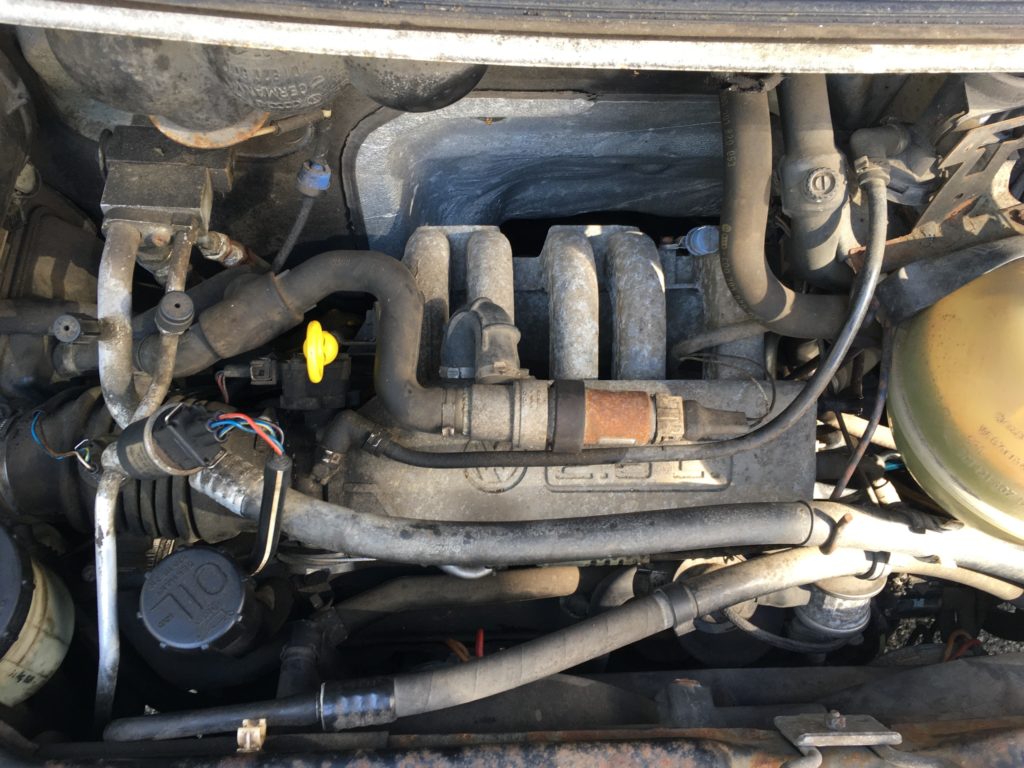
Hey, at least it’s German.
If this was a BMW, the car’s 1996 age would’ve put the ignition squarely in E36 territory, meaning individual stick coils hidden beneath a valve cover, with no visible plug wires. Instead, what I found looked for all the world like a conventional cylindrical distributor mounted on the block (like my Lotus Europa), with a round cap on it, one wire coming in from a “coil pack” mounted below the battery tray, and five plug wires. Most surprising—but at least it made troubleshooting it a straightforward process.
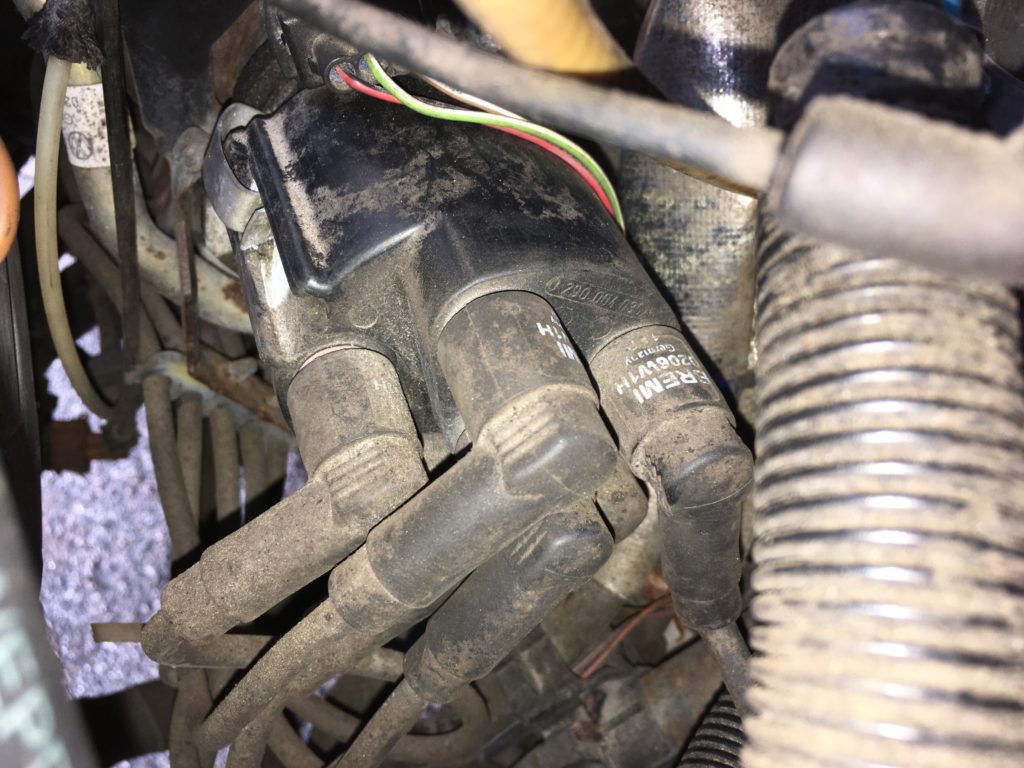
This looks like a conventional distributor, but it’s actually somewhat analogous to a Motronic “distributor” in that it doesn’t govern spark advance…

…except that it does have a pulse module and a reluctor plate inside, so it does govern triggering.
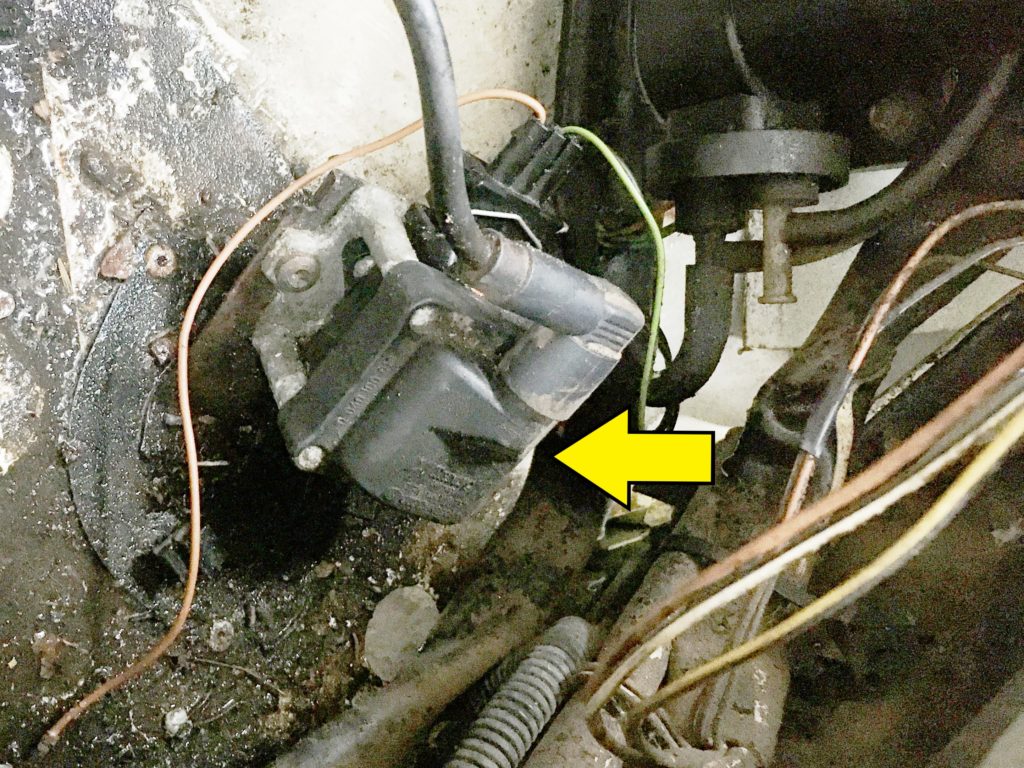
The Rialta’s somewhat foreign-to-BMW-world coil pack.
With Ethan cranking the engine, I checked for spark to the center of the cap. To my immense surprise, I had spark, and it looked fine. The plug wires are right up against the electric-cooling-fan housing and difficult to reach, but I was able to pull a connector off one of the plugs and test it: Yup, spark there, too. I put it back together, but the system still wouldn’t start.
Okay: We have fuel, we have spark, but we don’t have start—at which point you start thinking about things like a bad ground somewhere, or a broken timing belt. But then, two minutes later, it fired right up.
Still intermittent. Just freaking peachy.
Reading up on troubleshooting the Eurovan’s “Digifant” ignition, I learned that these things eat coil packs for lunch. I also saw confusing references to a crankshaft-position sensor, but eventually learned that this term was being misapplied to the pulse module that lives inside the distributor.
Then I began to see references to Eurovans and Rialtas experiencing what was referred to as “Sudden Death Syndrome,” in which cars, generally when warm, would lose power and die. Sometimes they’d revive if they sat, sometimes not. Many of the stories were heartbreaking, detailing trips interrupted by tows, hotel stays, expensive repair bills, and a recurrence of the problem 200 miles down the road. Some posts swore that the cause was a thermal-overload protector in the fuel pump tripping too early. Others implicated the pulse module. Neither of those is a trivial repair, the first requiring removal of the front seat and pulling up the carpet, the second necessitating removal of the distributor.
Sheesh, I thought, I’m about to subject my wife and myself to THIS? Here was a known history of similar-sounding trouble, and the car exhibiting intermittent symptoms. I’d be an idiot to drive it like this.
Okay, no: Don’t panic. This thing didn’t have “sudden death,” it just wouldn’t start—twice—when it was wet. Let’s get it wet.
I started the Rialta, took a garden hose and a spray nozzle, set it to the weakest, widest setting, and spritzed the coil pack. As I did it, I realized that if it didn’t die, an experiment with one data point doesn’t support much of a firm conclusion.
It sputtered and died almost instantly. Gotcha!
I dried everything to the point where it started again, and did one more test: With the engine running, I stuck my head down close to the coil pack, and lowered the hood to darken the engine compartment as much as possible. I then twisted the center wire coming out of the coil pack to the distributor. At certain positions, I could see and hear spark arcing from beneath the rubber boot. It was near certain that the pack was cracked, although I couldn’t see where.
I unbolted the coil pack from its position under the battery. With it removed, the crack on the side was plainly visible.
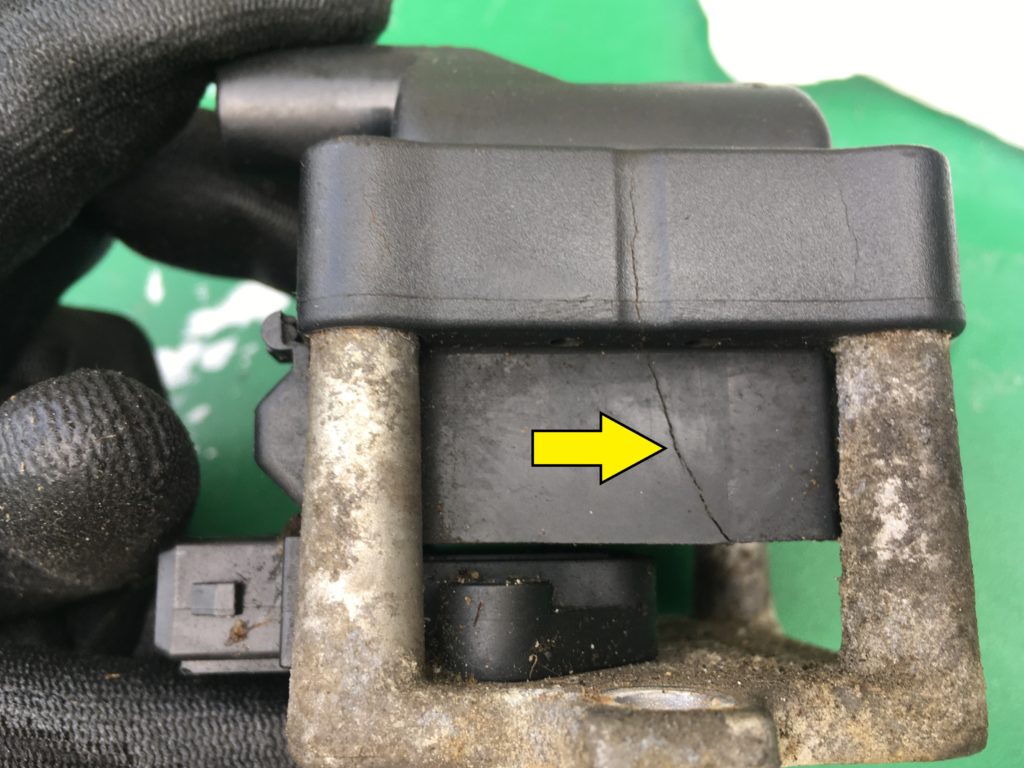
I love a smoking gun.
Plus, as was the case last week when I examined the date codes on my E39’s radiator and lower and upper hoses, the date code showed that the coil pack had never been changed. The fact that this hadn’t been changed when the previous owner paid a $3,900 for a pretty thorough maintenance that included plugs, wires, cap, and rotor was surprising.
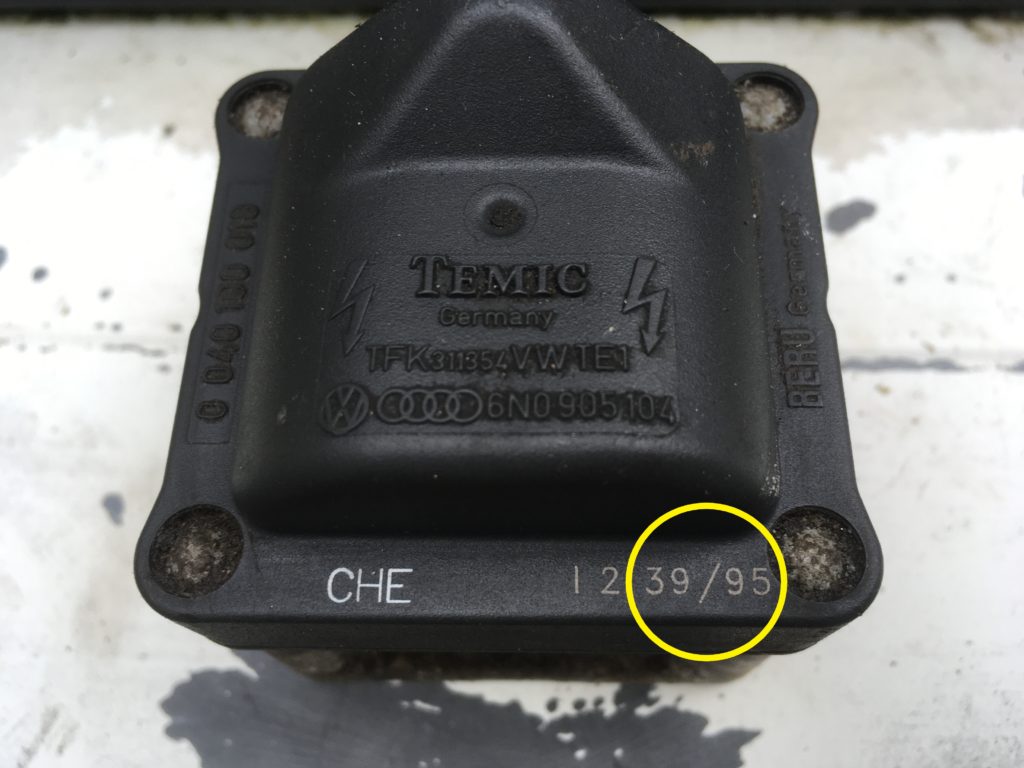
A well-aged coil.
By this point it was Monday morning. I had an appointment on Tuesday to have new tires installed (the ones on the vehicle were cracked), and Maire Anne and I were planning on heading out on Wednesday. Stores like Autozone do carry Digifant coil packs, but they’re expensive, and the aftermarket brands they stock don’t have a great reputation. FCP Euro down in Connecticut usually can get me parts the next day, but I felt that I had zero room for error. After all, if it rained the next morning, the odds of my even getting the RV to the tire shop were questionable.
I called FCP and verified that they had an OEM Beru coil pack in stock, and also asked about an OEM pulse module and fuel pump in case I was wrong or there were multiple issues. All three were in stock: $277 total, very reasonable.
I mapped the drive. It was about two-and-a-half hours each way. Snap decision: Order all three for in-store pickup and drive down now. Sometimes you want to search for the lowest possible price and put parts on order, but other times you do what is necessary to lay your hands on them because you can’t afford to be wrong about either delivery time or the cause of the problem.
When Bavarian Autosport in Portsmouth, New Hampshire, was still open, I used to occasionally shoot up there to pick up parts. They’d sometimes even leave stuff for me in the bushes so I could run up there after hours and pick it up if I needed it (I was a very good customer).
Things were more formal with FCP. Initially I asked that someone walk back into the warehouse and actually lay hands on the parts to verify that they were in stock and not just showing up that way online, and asked to place the order with the guarantee that it be ready when I arrived two-and-a-half hours later. The fellow I spoke with politely said that this wasn’t possible, and that instead I’d need to put in the order, wait for the confirmation that it was being processed, and wait for another email saying that it was ready. I understood, and settled for a “highly likely it’ll be ready when you arrive.” It all worked out fine.
Interesting question, though: which car to drive down from Boston to Milford (near New Haven). Having not yet serviced the E39, I wasn’t ready to take it out of town. Rain was forecast, so I was hesitant to drive any of the vintage cars. So the clown shoe it was. This was fun, as I hadn’t driven it since the whole Magnus Walker affair (the video of the M coupe in “The Next Big Thing With Magnus Walker” is now up on YouTube and can be seen here).
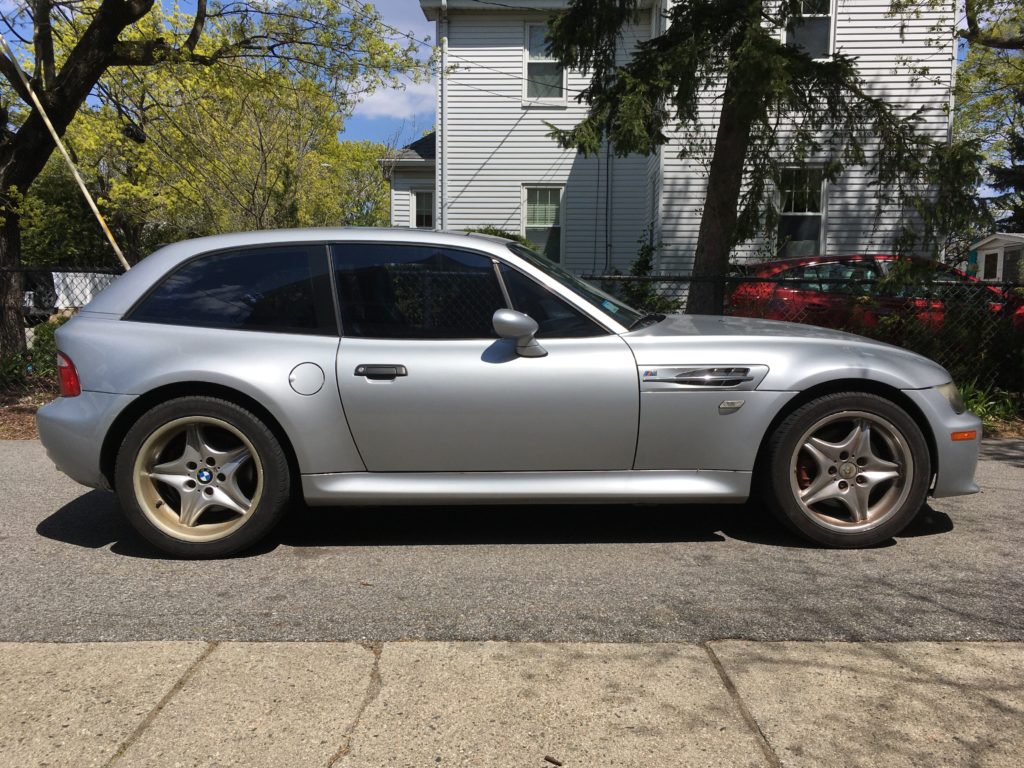
Hardship this was not.
It was totally the right call. I was back home by 3:00 p.m. Monday and installed the new coil. The Rialta started instantly, sounding smoother than before. I then sprayed the coil with water, and could not re-create the dying-when-wet behavior. I had the cracked tires replaced on Tuesday, and Maire Anne and I left on schedule Wednesday morning. The little RV behaved flawlessly on our jaunt to Provincetown and back. Stashed away in a cabinet in the RV are the spare OEM fuel pump and pulse module if the car ever experiences the dreaded Sudden Death Syndrome.
So, what’s the lesson here in the “dependability dilemma?” It’s actually pretty simple: Maintain the car in a way that if it does die and leave you stranded, you don’t feel like an idiot because you ignored clear warning signs. The forensic examination on the Rialta unearthed the cracked coil, so the path forward was crystal clear.
I’m still not convinced that the E39 actually needs a fuel pump, but would I feel like an idiot if the car stranded me and that was the cause? Hell, yes. A new fuel pump and cooling system are on the way.—Rob Siegel
Rob’s new book, The Best of The Hack Mechanic, is available here on Amazon, as are his seven other books. Signed copies can be ordered directly from Rob here.

